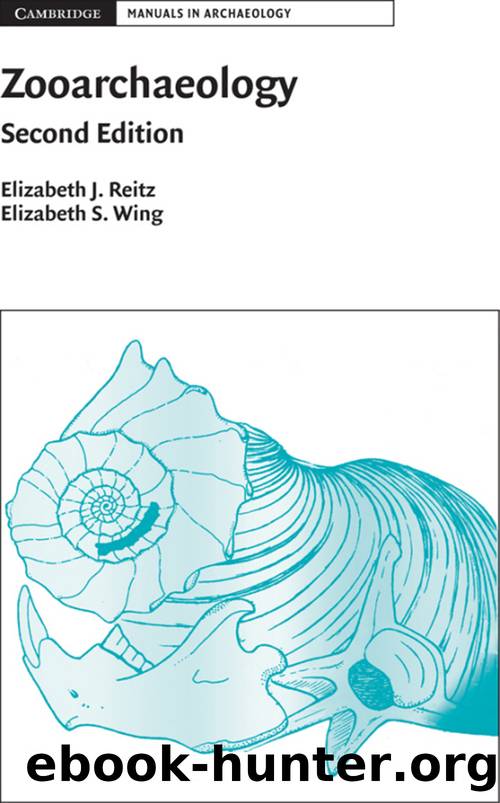Zooarchaeology by Elizabeth J. Reitz

Author:Elizabeth J. Reitz
Language: eng
Format: epub
Publisher: Cambridge University Press
FIGURE 8.3. Seasons of collecting for hard clams (Mercenaria mercenaria) based on characteristics of narrow translucent (T) growth increments and broader opaque (O) increments; viewed under transmitted light. The numbers refer to three shorter growth phases (1â3) within each growth increment (T or O). These shorter phases are derived from the relative width of each increment. Modified from Quitmyer et al. (1985:34); c (1985) by the Southeastern Archaeological Conference and reprinted by permission from Southeastern Archaeology Volume 4, Number 1, and Irvy R. Quitmyer.
If the death assemblage is sufficiently large, the relationship between age and sex in animal populations, known as population structure, provides information on the age at death and the season at death (Monks 1981). The age and sex composition of a living population varies seasonally, with variations within each population reflecting differences in sex and individual variation. If hunters or herdsmen target a specific age or sex following a seasonal schedule, this will be reflected in the archaeological materials as a cluster of animals into a specific sex or age group (e.g., Plug 1989). In cases of catastrophic death assemblages, such as those that may result from driving animals over a cliff, the age and sex profile will be more inclusive. Size of fish also may indicate targeted age classes and be associated with seasonal fishing, although capture technology and the choice of which fish habitat to exploit also play a role in the selection of fish size.
The archaeological context excavated is an important variable to consider when studying seasonal periodicity (Spiess and Lewis 1995). Settlement and refuse disposal patterns are sometimes associated with seasonal cycles in which human populations aggregate or disperse along with their chosen resources (Figure 8.2). Small summer, or winter, extractive camps are usually irregularly arranged and larger settlements occupied by more people during other seasons may be very formally organized. Some of these larger camps or villages are associated with community ceremonies, such as rites of passage (e.g., Meehan 1982:31â2). Some kinds of structures are associated with specific seasons, for example, heavy plank houses with winter and light-framed, informal structures with summer; internal versus external hearths; or the presence of storage pits (e.g., Monks 1981 :219; Wagner 2007). A large midden may accumulate if the site is occupied by many people over several years. Large sites may be occupied only during that part of the year when resources are abundant in the area, but reoccupied over several generations. Seasonal, extractive camps occupied briefly by only a few people would not be expected to have large accumulations of refuse. Trash deposits at extractive sites may contain the remains of only a few species whose physiological processes indicate they all died during the same season.
For these reasons, some resources used by a community will not be deposited or recovered within the excavated area. If the human community had separate summer and winter houses at the same site, and only refuse from the summer house is studied, this will bias the interpretation (e.g., Wagner 2007; Zeder and Arter 2007).
Download
This site does not store any files on its server. We only index and link to content provided by other sites. Please contact the content providers to delete copyright contents if any and email us, we'll remove relevant links or contents immediately.
Essentials of Geology by Stephen Marshak(391)
Spectral Geometry and Inverse Scattering Theory by Huaian Diao & Hongyu Liu(282)
Probably Overthinking It: How to Use Data to Answer Questions, Avoid Statistical Traps, and Make Better Decisions by Allen B. Downey(269)
The Readable Darwin by Pechenik Jan A.;(263)
Hydrocarbon transformations in sediments from the Cathedral Hill hydrothermal vent complex at Guaymas Basin, Gulf of California ââ¬â A chemometric study of shallow seep architecture by unknow(262)
How to succeed in EPSO numerical reasoning tests by Franco Reverte José María(241)
Research and Publication Ethics by Santosh Kumar Yadav(233)
Great Ways to Learn Anatomy and Physiology by McKissock Charmaine;(232)
Mathematical Models in Economics. Lections by Shananin(232)
Quantum International Relations by James Der Derian(231)
Weathering: Types, Processes and Effects: Types, Processes and Effects by Matthew J. J. Colon(228)
Dark Matter in the Universe by John N. Bahcall(225)
Fusion of Defects by Arthur Bartels; Christopher Douglas; André Henriques(214)
Cosmic Rays by Alessandro De Angelis(211)
Mathematics Booster-1 by Singh Manoj Kumar(207)
The Structure of Scientific Inference by Mary B. Hesse(206)
Sampling by Lohr Sharon L.;(205)
Pearls from a Lost City: The LVOV School of Mathematics (History of Mathematics) (History of Mathematics, 40) by Roman Duda(202)
Flora Unveiled by Taiz Lincoln;Taiz Lee;(190)
